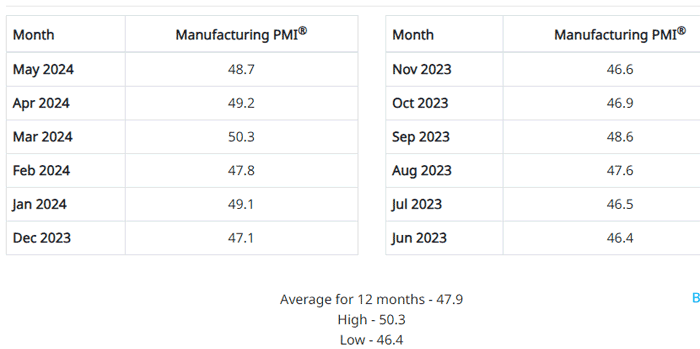The US Purchasing Managers Index (PMI) for May was released Monday by the Institute for Supply Management (ISM), and came at a level of 48.7, again below the key 50 mark that separates US manufacturing expansion from contraction.
The US PMI had previously been in contraction territory for 16 straight months until it poked its head into expansion in March, but fell back to contraction in April and May
The overall economy continued in expansion for the 49th month after one month of contraction in April 2020. The PMI tracks closely but not exactly with the overall US economy.
A Manufacturing PMI above 42.5, over a period of time, generally indicates an expansion of the overall economy, according to ISM.
The other PMI numbers we track were mixed but mostly negative.
That starts with the New Order Index, which registered 45.4, 3.7 percentage points lower than the 49.1 score recorded in April, in a bad sign for future US manufacturing activity.
The May reading of the Production Index, at 50.2, was 1.1 percentage points lower than April’s figure of 51.3, but still barely showing expansion.
The Prices Index registered 57.0, down 3.9 percentage points compared to the reading of 60.9 in April.
That means companies saw a sharp rise in the cost of components, materials and other inputs (below 50 = falling prices), but not as much as the previous month.
In more negative news, the Backlog of Orders Index measured 42.4, down 3 percentage points compared to the 45.4 percent recorded in April. That means the order book of most companies is shrinking, with the level still well below the 50 mark.
The Supplier Deliveries Index figure of 48.9 was the same as that recorded in April, and also under the 50 mark.
Supplier Deliveries is the only ISM index that is inversed, with a reading of above 50 indicating slower deliveries, which is typical as the economy improves and customer demand increases - or the reverse.
The Inventories Index came in 47.9, down 0.3 percentage point compared to April’s reading of 48.2, with the score below 50 indicating inventory levels at companies are again decreasing.
Said Timothy Fiore, Chair of the Institute for Supply Management Manufacturing Business Survey Committee: “US manufacturing activity continued in contraction after growing in March, the first expansion for the sector since September 2022. Demand was soft again, output was stable, and inputs stayed accommodative.”
He added: “Demand remains elusive as companies demonstrate an unwillingness to invest due to current monetary policy and other conditions. These investments include supplier order commitments, inventory building and capital expenditures.”
(See More Below)
|
CATEGORY SPONSOR: SOFTEON |
|
|
| |
| |
|
|
As always, the ISM report provides a graphic of the full PMI scores the last 12 months, which as can be seen indicates the measure has below the key 50 mark since November 2022, with the exception of March 2024. It is now averaging just 47.9 over the past year.
US PMI Last 12 Months

Source: ISM
Of the 18 sectors tracked by ISM, seven manufacturing industries reporting growth in April. They are, in order: Printing & Related Support Activities; Petroleum & Coal Products; Paper Products; Textile Mills; Primary Metals; Fabricated Metal Products; and Chemical Products.
As always, there were some interesting comments from PMI survey respondents.
“Seems like a minor slowdown is happening. With less spending in the economy, less pressure on us for our products,” said one manager in the chemicals sector.
Added one respondent machinery sector: “Backlog is dwindling as we get caught up on orders; new orders are not coming in as robust as the backlog is going down. Inflation continues to be a problem with pricing of raw material and interest rates. We expect a flat rest of calendar year 2024, especially given that it’s a presidential election year.”
Finally, a manager in the metals sector noted a “General concern about overall industry economics. Pricing weakness continues, and we anticipate more headwinds in the coming months for spot orders and inflation. Contract order book remains steady.”
Any reaction to the May PMI? Let us know your thoughts at the Feedback section below.
|